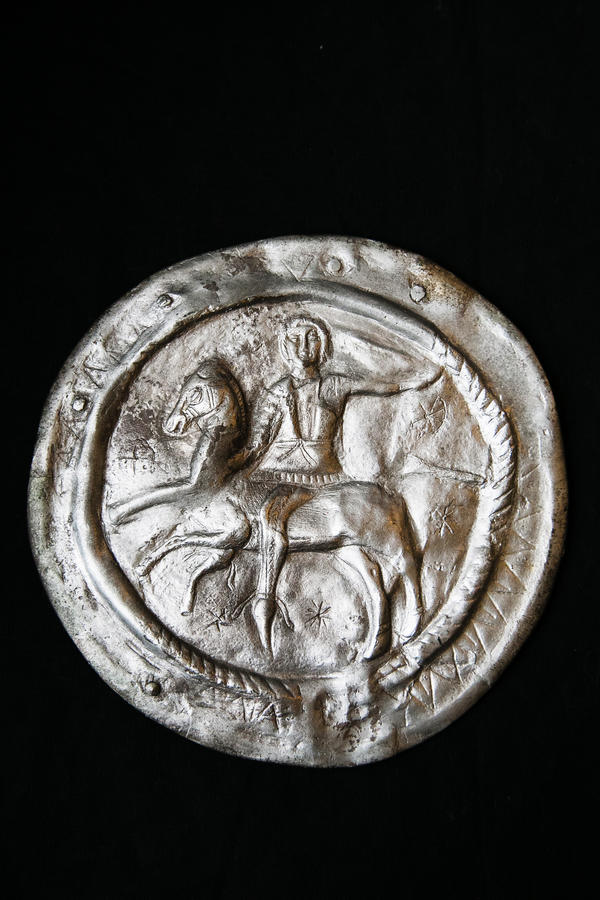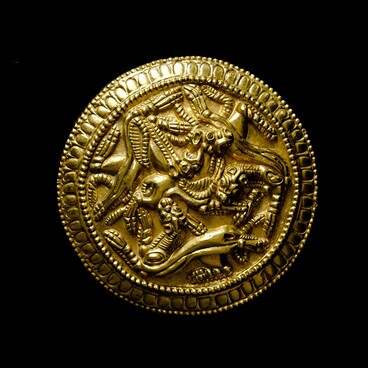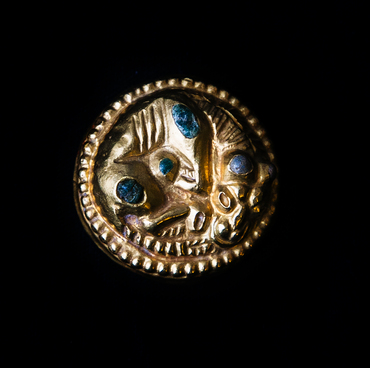Phalerae are items for decorating horse harnesses and distributing harness belts. This one was found in a hiding of a Sarmatian warrior’s burial mound. The phalerae are paired. They were found bent and rolled up since the Sarmatians had a custom to break certain things before lowering them into the graves. In addition to the phalerae, an iron sword, arrowheads, and a quiver hook were found in the burial mound.
The phalera is decorated with a repoussé image of a horseman. To make the pattern, an ancient craftsman worked the item back side with an embossing die. After that, the image was engraved and embossed again outside. The front side of the phalera was gilded, which was revealed by experts during the restoration activities at the All-Union Central Research Institute of Conservation and Restoration.
The left hand of the rider is raised up and holds the spear, the right one is lowered. The rider is dressed in a shirt with a cutout; stripes on the shoulders are clearly visible, possibly they are shoulder pieces. The shirt hem is fringed with a ribbed strip ornament. The tight fit trousers end at the ankle, where you can see a strap or a foot loop. The rider’s neck is decorated with a torc. His posture is borrowed from Greek art where it emerged in the classical times and then was widely spread both in the Black Sea region and in Iran.
The horse has both front legs raised; there is no saddle and bit. The hogged mane is typical for war horses.
There are six solar symbols carved around the rider: three circled asterisks with beams and three ones without circles. Scientists suggest that it was the metal craftsman method to connotate a divine nature of the character.
All images are bordered with a bead of oblique incisions imitating a cord. There is a strip of zigzag ornament behind the bead. The bronze wire eyes are attached to the edges with silver rivets. Such phalerae were fastened with straps on the sides of horses.
This exhibit from the Astrakhan Museum Reserve collection was found by the Volga archaeological expedition from the Institute of Archeology of the USSR Academy of Sciences. The expedition worked at the construction site of the first stage of the Astrakhan-KalmYk rice irrigation system, in the vicinity of the dry bed of the KrivAya LUka creek of the Volga river in the ChernoYArsky District of the Astrakhan Region in 1974. The team was led by HErman FEdorov-DavYdov.
In 2005, the phalera and other finds were exhibited at the Astrakhan Steppe Treasures show at the National Museum of the Palazzo Venezia in Rome.
The phalera is decorated with a repoussé image of a horseman. To make the pattern, an ancient craftsman worked the item back side with an embossing die. After that, the image was engraved and embossed again outside. The front side of the phalera was gilded, which was revealed by experts during the restoration activities at the All-Union Central Research Institute of Conservation and Restoration.
The left hand of the rider is raised up and holds the spear, the right one is lowered. The rider is dressed in a shirt with a cutout; stripes on the shoulders are clearly visible, possibly they are shoulder pieces. The shirt hem is fringed with a ribbed strip ornament. The tight fit trousers end at the ankle, where you can see a strap or a foot loop. The rider’s neck is decorated with a torc. His posture is borrowed from Greek art where it emerged in the classical times and then was widely spread both in the Black Sea region and in Iran.
The horse has both front legs raised; there is no saddle and bit. The hogged mane is typical for war horses.
There are six solar symbols carved around the rider: three circled asterisks with beams and three ones without circles. Scientists suggest that it was the metal craftsman method to connotate a divine nature of the character.
All images are bordered with a bead of oblique incisions imitating a cord. There is a strip of zigzag ornament behind the bead. The bronze wire eyes are attached to the edges with silver rivets. Such phalerae were fastened with straps on the sides of horses.
This exhibit from the Astrakhan Museum Reserve collection was found by the Volga archaeological expedition from the Institute of Archeology of the USSR Academy of Sciences. The expedition worked at the construction site of the first stage of the Astrakhan-KalmYk rice irrigation system, in the vicinity of the dry bed of the KrivAya LUka creek of the Volga river in the ChernoYArsky District of the Astrakhan Region in 1974. The team was led by HErman FEdorov-DavYdov.
In 2005, the phalera and other finds were exhibited at the Astrakhan Steppe Treasures show at the National Museum of the Palazzo Venezia in Rome.



